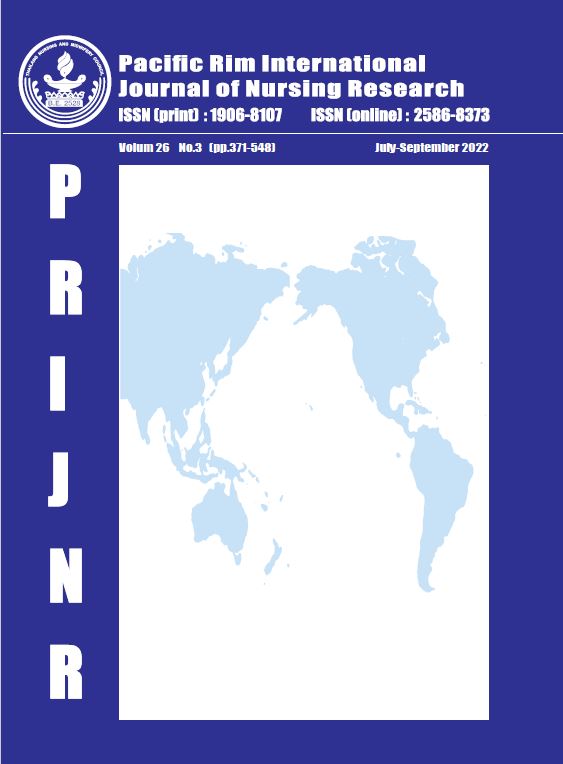Psychometric Properties of Beliefs about Pain Control Questionnaire in People with Cancer – Thai Version
Keywords:
Beliefs, Cancer, Factor analysis, Pain Control, Psychometric Testing, QuestionnaireAbstract
Peoples’ belief about pain control is the key factor of effective pain management. Understanding such beliefs about pain control will help healthcare providers deliver appropriate pain management. The Beliefs about Pain Control Questionnaire, developed by Suzanne Skevington, is a popular tool for assessing pain belief. This questionnaire comprises three subscales of an individual’s belief in pain control: internal factors, power of doctors, and by chance events. The purpose of this study was to translate and examine the psychometric properties of this questionnaire. Convenience sampling was used to recruit 155 Thais with cancer to test the questionnaire. The Cronbach’s alpha was computed for reliability. The confirmatory factor analysis was examined for the factor structure of the questionnaire.
The construct validity of the Thai Beliefs about Pain Control Questionnaire was confirmed with remaining the original 13 items with the three-subscale model of internal factors, power of doctors, and pain controlled by chance events. The overall internal consistency reliability (a = 0.74) and each domain had a reliability coefficient of internal factors (a = 0.58), power of doctors (a = 0.75), and by chance events (a = 0.32). In conclusion, the Thai questionnaire version is short and convenient for a self-report questionnaire. Nurses could use the questionnaire to assess people with cancer in clinical settings and design interventions to improve self-efficacy and pain management empowerment. However, further refinements, especially in internal and chance events, are still needed to confirm whether the questionnaire equates with Thai beliefs.
References
Sung H, Ferlay J, Siegel RL, Laversanne M, Soerjomataram I, Jemal A, et al. Global cancer statistics 2020: GLOBOCAN estimates of incidence and mortality worldwide for 36 cancers in 185 countries. CA Cancer J Clin. 2021;71(3): 209-49. doi: https://doi.org/10.3322/caac.21660.
World Health Organization. WHO South-East Asia Region (SEARO): WHO. 2020 October [cited 2021 July 31]. Available from: https://gco.iarc.fr/today/data/factsheets/populations/995-who-south-east-asia-region-searofact-sheets.pdf
World Health Organization. Thailand. 2021 March 31 [cited 2021 July 31]. Available from: https://gco.iarc. fr/today/data/factsheets/populations/764-thailand- factsheets.pdf
Ko HJ, Seo SJ, Youn CH, Kim HM, Chung SE. The Association between pain and depression, anxiety, and cognitive function among advanced cancer patients in the hospice ward. Korean J Fam Med. 2013;34(5):347-56. doi: 10.4082/kjfm.2013.34.5.347.
Mattern M, Walter H, Hentze C, Schramm E, Drost S, Schoepf D, et al. Behavioral evidence for an impairment of affective theory of mind capabilities in chronic depression. Psychopathology. 2015;48(4):240-50. doi: 10.1159/000430450.
Henselmans I, Fleer J, de Vries J, Baas PC, Sanderman R, Ranchor AV. The adaptive effect of personal control when facing breast cancer: cognitive and behavioural mediators. Psychol Health. 2010;25(9):1023-40. doi: 10.1080/08870440902935921.
Liamputtong P, Suwankhong D. Living with breast cancer: the experiences and meaning-making among women in Southern Thailand. Eur J Cancer Care. 2016;25(3):371-80. doi: 10.1111/ecc.12321.
Xu X, Luckett T, Wang AY, Lovell M, Phillips JL. Cancer pain management needs and perspectives of patients from Chinese backgrounds: a systematic review of the Chinese and English literature. Palliat Support Care. 2018:1-15. doi: 10.1017/s1478951517001171.
Czerw A, Religioni U, Deptała A, Fronczak A. Application of the BPCQ questionnaire to assess pain management in selected types of cancer. Ann Agric Environ Med. 2016;23(4):677-82. doi: 10.5604/12321966.1220212.
Kadłubowska M, Bąk E, Marcisz C, Kózka M, Michalik A, Kolonko J, et al. Perception vs pain and beliefs about pain control and Type A behavior pattern in patients with chronic ischemia of lower extremities or with rheumatoid arthritis. J Pain Res. 2018;11:3051-9. doi: 10.2147/
JPR.S182703.
Skevington SM. Pain control and mechanisms for the measurement of pain. J Psychopharmacol. 1991;5(4): 360-3. doi: 10.1177/026988119100500426.
Kulpa M, Kosowicz M, Stypula-Ciuba BJ, Kazalska D. Anxiety and depression, cognitive coping strategies, and health locus of control in patients with digestive system cancer. Prz Gastroenterol. 2014;9(6):329-35. doi:10.5114/pg.2014.47895.
Berglund E, Lytsy P, Westerling R. The influence of locus of control on self-rated health in context of chronic disease: a structural equation modeling approach in a cross sectional study. BMC Public Health. 2014;14:492. doi: 10.1186/1471-2458-14-492.
Timmerman L, Stronks DL, Huygen FJ. The relation between patients’ beliefs about pain medication, medication adherence, and treatment outcome in chronic pain patients: a prospective study. Clin J Pain. 2019;35(12):941-7. doi: https://doi.org/10.1097/AJP.0000000000000760.
Jensen MP, Karoly P, Huger R. The development and preliminary validation of an instrument to assess patients’ attitudes toward pain. J Psychosom Res. 1987;31(3):393-400. doi: 10.1016/0022-3999(87)90060-2.
Edwards LC, Pearce SA, Turner-Stokes L, Jones A. The pain beliefs questionnaire: an investigation of beliefs in the causes and consequences of pain. Pain. 1992;51(3):267-72. doi: 10.1016/0304-3959(92)90209-T.
Skevington SM. A standardised scale to measure beliefs about controlling pain (BPCQ): a preliminary study. Psychol Health. 1990;4(3):221-32. doi: 10.1080/08870449008400392.
Coutu M-F, Durand M-J, Baril R, Labrecque M-E, Ngomo S, Côté D, et al. A review of assessment tools of illness representations: are these adapted for a work disability prevention context? J Occup Rehabil. 2008; 18(4):347-61. doi: 10.1007/s10926-008-9148-x.
Kowalczuk K, Cybulski M, Cybulski Ł, Krajewska-Kułak E. Pain perception and acceptance of illness in patients undergoing phacoemulsification cataract surgery under drip anesthesia. J Clin Med. 2019;8(10):1575. doi:https://doi.org/10.3390/jcm8101575.
Czerw AI, Religioni U, Deptala A, Fronczak A. Pain, acceptance of illness, adjustment to life with cancer and coping strategies in prostate cancer patients. Arch Med Sci. 2017;81459-66. doi: https://doi.org/10.5114/aoms.2016.58458.
Czerw A, Religioni U, Deptala A. Assessment of pain, acceptance of illness, adjustment to life with cancer and coping strategies in breast cancer patients. Breast Can. 2016;23:654-61. doi: 10.5114/pg.2015.52561.
Czerw A, Religioni U, Deptała A. Assessment of pain, acceptance of illness, adjustment to life with cancer and coping strategies in breast cancer patients. Breast Can. 2016;23(4):654-61. doi: 10.1007/s12282-015-0620-0.
Sperber AD. Translation and validation of study instruments for cross-cultural research. Gastroenter. 2004;126: S124-S8. doi: 10.1053/j.gastro.2003.10.016.
Jones PS, Lee JW, Phillips LR, Zhang XE, Jaceldo KB. An adaptation of Brislin’s translation model for crosscultural research. Nurs Res. 2001;50(5):300-4. doi:10.1097/00006199-200109000-00008.
Lynn MR. Determination and quantification of content validity. Nurs Res. 1986;35(6):382-5. doi: 10.1097/00006199-198611000-00017.
Nunnally JC, Bernstein IH. Psychometric theory. New York, NY: McGraw-Hill; 1967.
Kyriazos T. Applied psychometrics: sample size and sample power considerations in factor analysis (EFA, CFA) and SEM in general. Psych. 2018;09:2207-30. doi:10.4236/psych.2018.98126.
Brown CA. The beliefs of people with chronic pain in relation to "important" treatment components. Eur J Pain. 2004;8(4):325-33. doi: 10.1016/j.ejpain.2003.10.005.
Sak JJ, Sagan D, Pawlikowski J, Wiechetek M, Jarosz M. Impact of beliefs about pain control on perceptions of illness in surgical patients. Ann Agric Environ Med. 2016; 23(1):144-7. doi: 10.5604/12321966.1196870.
Hair J, Black W, Babin B, Anderson R. Multivariate data analysis: a global perspective. 5th ed. Boston: Pearson Education; 2010.
Milfont TL, Fischer R. Testing measurement invariance across groups: applications in cross-cultural research. Int J Psychol Res. 2010;3(1):111-30. doi: https://doi.org/10.21500/20112084.857.
Carmines EG, Zeller RA. On establishing the empirical dimensionality of theoretical terms: an analytical example. Political Methodology. 1974:75-96. doi: http://www.jstor.org/stable/25791395.
Carmines EG, Zeller RA. Reliability and validity assessment: Sage publications; 1979.
De Vaus D, de Vaus D. Surveys in social research. London:Routledge; 2013.
Hu LT, Bentler PM. Cutoff criteria for fit indexes in covariance structure analysis: conventional criteria versus new alternatives. Struct Equ Model. 1999;6(1):1-55.doi: 10.1080/10705519909540118.
Keith TZ. Multiple regression and beyond. United States of America: Pearson Education Inc; 2005.
Swami V, Barron D. Translation and validation of body image instruments: challenges, good practice guidelines, and reporting recommendations for test adaptation. Body Image. 2019;31:204-20. doi: https://doi.org/10.1016/j.bodyim.2018.08.014.
Gauthier AP, Lariviere M, Young N. Psychometric properties of the IPAQ: a validation study in a sample of northern Franco-Ontarians. J Phys Act Health. 2009;6(s1): S54-S60. doi: https://doi.org/10.1123/jpah.6.s1.s54.
Czerw A, Religioni U, Szymański F, Sygit K, Zdziarski K, Mękal D, et al. Pain control: normalization of the BPCQ questionnaire on a group of patients diagnosed with malignant cancer. Int J Environ Res Public Health. 2021;18(24): 13069. doi: https://www.mdpi.com/1660-4601/18/ 24/13069.
Moore RE. Religious practices and considerations for cancer treatment of Christian, Jewish, Islamic, and Buddhist patients. 2014. doi: http://scholarworks.gvsu.edu/honorsprojects/291.
Downloads
Published
How to Cite
Issue
Section
License
Copyright (c) 2022 Pacific Rim International Journal of Nursing Research

This work is licensed under a Creative Commons Attribution-NonCommercial-NoDerivatives 4.0 International License.
Copyright: The Pacific Rim International Journal of Nursing Research, Thailand Nursing & Midwifery Council has exclusive rights to publish, reproduce and distribute the manuscript and all contents therein.








.png)



